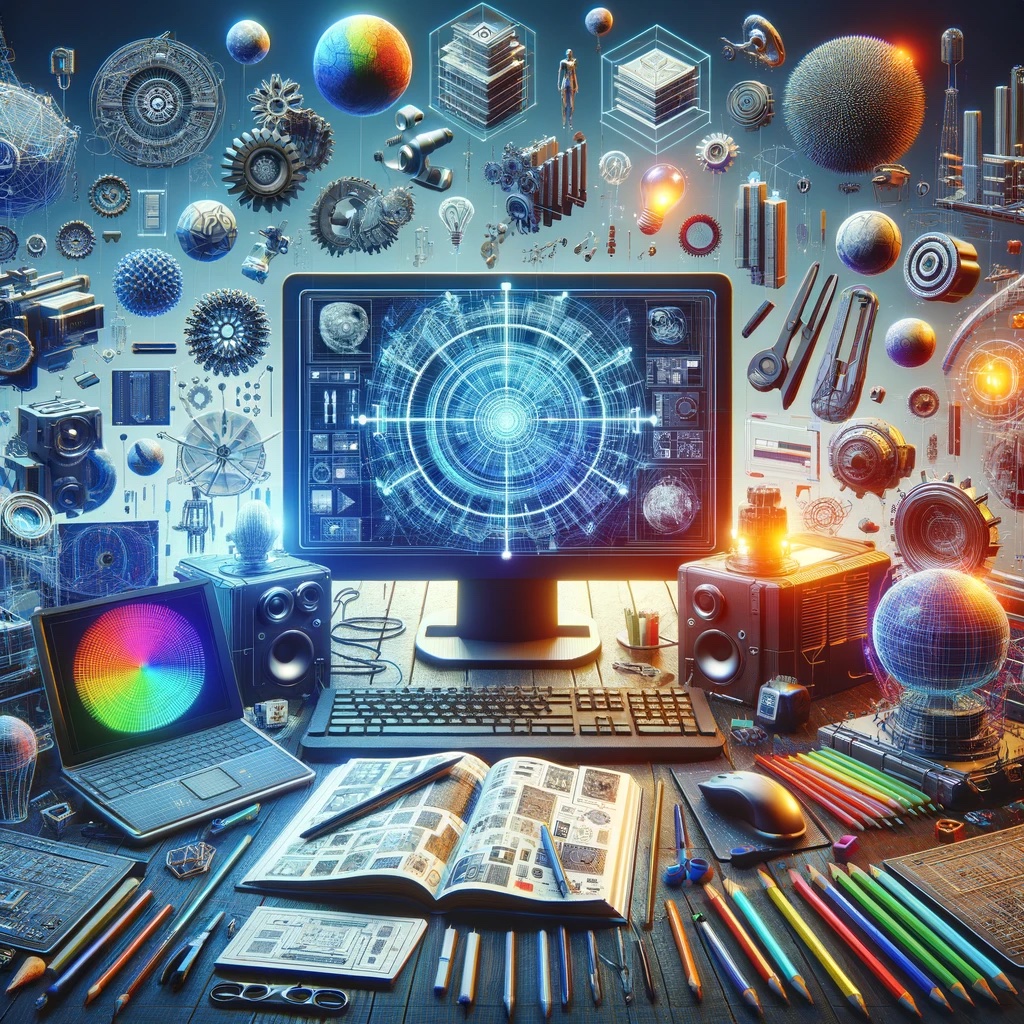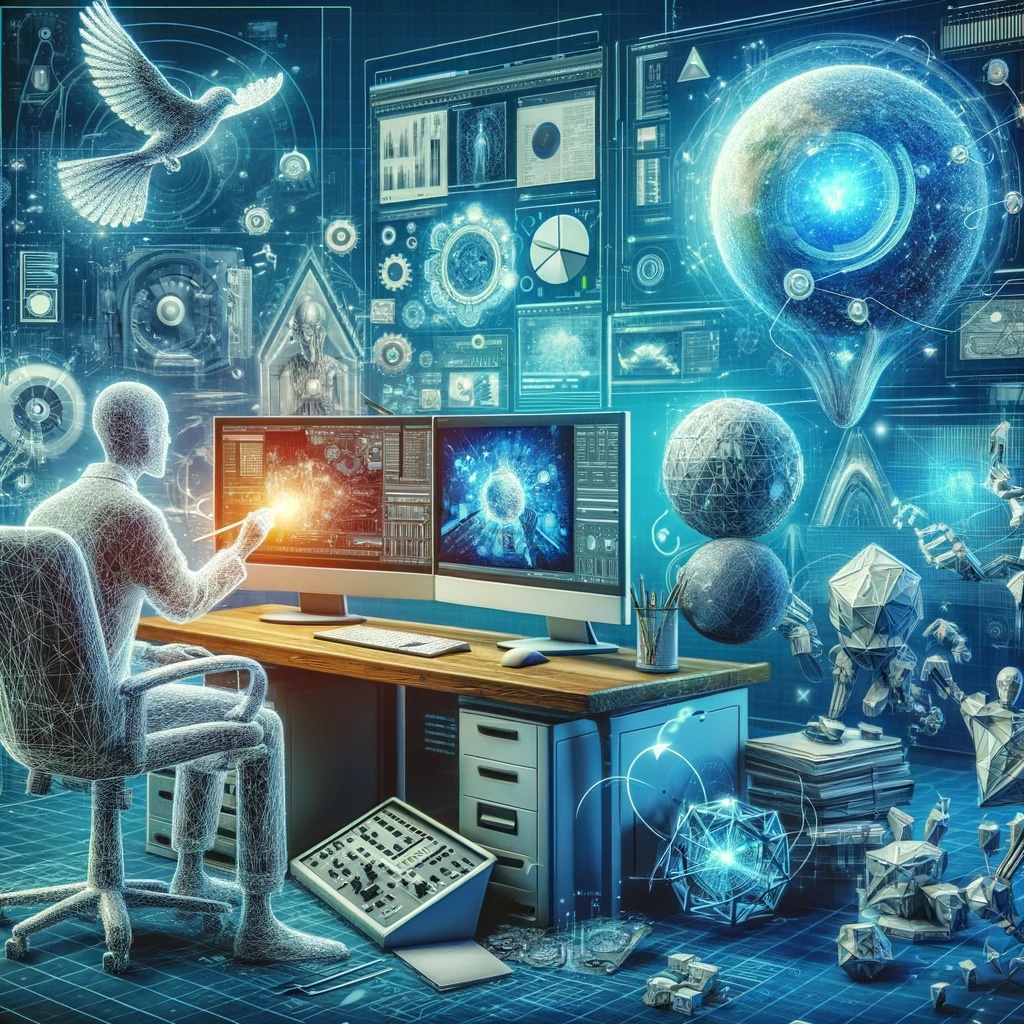
In the enigmatic realm of digital art and design, 3D rendering emerges as a quintessential process, serving as an impetus for awe-inspiring visuals that captivate and stimulate our senses. It’s an advanced technique of converting three-dimensional models or scenes stored within a computer into two-dimensional images or animations.
This intricate process includes mapping textures, placing lights, setting camera angles, defining atmospheric variables- all placed meticulously to engender a lifelike image or video. The art of 3D rendering transcends boundaries, finding utility across diverse fields from architecture to gaming and film-making.
The Power Within: Why Your Laptop Matters in 3D Rendering
As you delve deeper into the labyrinthine world of 3D rendering, you realize that this endeavor demands more than just skills; it calls for an exceptional computing companion – your laptop. The significance of a potent laptop cannot be overstated in this context. Rendering is an intensive task; every polygon rendered and every pixel illuminated taxes your system’s capabilities.
An underpowered laptop might trudge through simple tasks but will falter when confronted with complex scenes involving high-resolution textures or advanced lighting effects. Henceforth, to bring your imagination to life without enduring frustrating lags or crashes, it becomes paramount to invest in a capable machine.
A Guiding Light: Navigating Through The Complex World Of Laptop Selection
This guide is designed as a beacon for professionals seeking resolute answers amidst the whirlwind of options available in today’s laptop market. Its purpose is manifold- it aims not only to help readers identify their unique needs but also equips them with crucial knowledge needed to evaluate different models effectively.
Delving into essential hardware requirements for efficient rendering and exploring various factors that influence the choice of a laptop, this guide aims to be an indispensable companion in your journey towards procuring the perfect laptop for 3D rendering. Prepare yourself as we embark on this enlightening expedition into the world of powerful computing.
Understanding 3D Rendering and its Requirements

The Intricacies of the 3D Rendering Process
The art of 3D rendering is a complex computational process, which transforms three-dimensional models into two-dimensional images or animations with photographic realism. This fascinating process involves using algorithms to simulate light transport, thereby accurately portraying how surfaces and materials look in real life. The rendering stage is pivotal in numerous industries, from architecture and video games to movies and virtual reality.
Deciphering the Hardware Demands of 3D Rendering
Harnessing the power of modern computing for effective 3D rendering necessitates appreciating the hardware requirements this sophisticated process demands. As one delves deeper into professional-grade rendering tasks, it becomes increasingly evident that standard consumer-grade hardware often falls short. A profound understanding of individual hardware components’ roles will arm you with the knowledge required to select a laptop adept at tackling intensive 3D rendering tasks.
The Crucial Role and Specifications of CPU in Rendering
Unquestionably, the Central Processing Unit (CPU) is a key player in executing calculations needed for rendering. It’s responsible for handling ray tracing – calculating paths of light rays as they bounce around objects in your scene – which is fundamental to achieving realistic results. Equally important are considerations such as the number of cores and threads that directly impact multitasking capabilities, clock speed determining processing speed per core, cache size affecting data accessibility speed, as well as thermal design power indicating heat output under maximum load.
Importance and Specifications of GPU for Enhanced Rendering Performance
In most recent years, Graphics Processing Units (GPUs) have risen to prominence in accelerating certain types of renders known as GPU renders. Contrary to CPUs that excel at complex calculations done sequentially, GPUs are designed to handle a vast number of simple calculations simultaneously, making them perfect for rendering tasks that can be parallelized. Key GPU specs encompass core count which reflects parallel processing power, memory size and bandwidth affecting data storage and retrieval speed, as well as the architecture underlying its design and capabilities.
RAM Requirements: An Indispensable Aspect of Rendering
Random Access Memory (RAM) holds an indispensable place in the grand scheme of 3D rendering. Its primary role is to store the 3D model data and textures that are currently being manipulated or rendered.
Inadequate RAM could lead to longer render times or even render failure if your scenes cannot fit into available memory. The general rule of thumb here is, the more complex your scenes and textures are, the more RAM you’ll need.
A Look at Storage Types and their Impact on Performance
Last but certainly not least comes storage – an oft-underestimated factor influencing rendering performance. Modern laptops predominantly offer two types – Hard Disk Drives (HDDs) and Solid State Drives (SSDs).
While SSDs have a higher price tag attached to them than their HDD counterparts, they excel at read-write speeds significantly reducing loading times for large files typical in high-quality renders. Furthermore, with M.2 NVMe SSDs becoming increasingly commonplace in high-end laptops today, users can enjoy even faster data access times.
Factors to Consider when Choosing a Laptop for 3D Rendering

The Performance Equation: CPU, GPU, RAM, Storage
Performance is a paramount criterion in choosing a laptop designed for 3D rendering. The Central Processing Unit (CPU) is the beating heart of any computer system, and the importance of its speed cannot be overstated; it directly influences the speed of rendering operations.
Opt for multi-core processors as they enhance multitasking and efficiency. The Graphics Processing Unit (GPU), on the other hand, powers real-time viewport graphics and increasingly contributes to final frame rendering.
Thus, a high-performing dedicated GPU should also be on your checklist. Random Access Memory (RAM) enables fast access to data that your system uses frequently.
For 3D rendering tasks that often involve robust data processing, an ample amount of high-speed RAM is recommended—think 16GB or more. Consider storage options: Solid State Drives (SSDs) provide faster boot times and data access compared to traditional Hard Disk Drives (HDDs), leading to overall performance improvements.
A Canvas Reimagined: Screen Size, Resolution & Color Accuracy
Next up is display quality—an often-underestimated factor in this selection process. A large screen size can provide ample workspace for your 3D projects while resolution determines the sharpness of images and objects you’d be working with—four K resolution would provide crisp images with detailed textures allowing for meticulous work. Additionally, color accuracy plays a crucial part in delivering high-quality renders; look out for panels boasting good coverage of Adobe RGB or DCI-P3 color spaces.
Built Like a Masterpiece: Durability & Design Aesthetics
Remember that your laptop represents an investment into your craft—it should, therefore, possess build quality commensurate with your expectations. A sturdy, robust construction is desirable for longevity.
Also pay heed to design aesthetics: a laptop with superior ergonomics can significantly improve your work experience. The keyboard layout, trackpad responsiveness, speaker sound quality—all contribute to the overall user experience.
The Traveling Artist’s Companion: Weight & Size
Portability might not be a primary concern if you predominantly work from a single location. However, if you often find yourself on the move—be it between home and office or across cities—a lightweight and compact laptop could prove invaluable. But remember: portability should not compromise performance; balance is key.
Energizing Creativity: Battery Life
Strong battery life comes in handy when there’s an absence of power outlets or during long commutes—scenarios where rendering projects often suffer interruptions. Laptops that provide several hours of run time under heavy workloads help maintain your workflow’s continuity even when unplugged.
The Value Proposition: Balancing Budget with Needs
Price plays an inevitably significant role in the decision-making process. High-end laptops often offer unmatched performance but may extend beyond budget constraints; mid-range options strike a balance between cost and features while entry-level models are budget-friendly but may not pack enough punch for complex 3D rendering tasks. It’s crucial to carefully evaluate your specific needs against what you are willing and able to spend—a delicate yet essential balancing act in finding the ideal laptop for 3D rendering.
Reviewing the Best Laptops for Different User Needs: A Traverse Across Price Brackets and User Expectations

High-end Laptops for Professionals: Powerhouse Performance at Your Fingertips
Renowned for its potent computing prowess, the ASUS ROG Zephyrus Duo 15 is a formidable contender in the high-end laptop domain. It comes armed with an Intel Core i9 processor and Nvidia GeForce RTX 2080 Super GPU, providing a seamless experience even for most demanding of rendering tasks. Its unique selling proposition lies in its dual screen setup that can significantly enhance multitasking capabilities, giving professionals an edge in efficiency.
In terms of pros, the Zephyrus Duo offers unparalleled processing power, top-notch graphics performance, and advanced cooling technology. The innovative secondary display caters to enhanced productivity.
Nevertheless, it does come with certain limitations. Its hefty price tag might be prohibitive to some buyers while its substantial weight undermines its portability.
Mid-range Laptops for Semi-professionals or Students: Balancing Budget and Performance
For those seeking a balance between cost and capability, Dell’s G5 15 strikes a thoughtful blend. Furnished with an Intel Core i7 CPU and Nvidia GeForce GTX 1660 Ti GPU, it delivers consistent performance adequate to handle moderate rendering tasks with relative ease. The advantages of this model include reliable performance considering its mid-range status along with robust build quality that ensures longevity.
It also boasts impressive thermal management ensuring sustained performance during extended usage. On the downside though, it falls short on battery life and display color accuracy compared to higher-end models.
Budget-friendly Laptops for Beginners or Hobbyists: Affordability Meets Functionality
For beginners venturing into the realm of 3D rendering or hobbyists on a tighter budget, Acer Aspire E15 emerges as a commendable choice. While it cannot compete with the power of high-end models, its 8th Gen Intel Core i5 processor coupled with NVIDIA GeForce MX150 GPU can handle basic rendering tasks convincingly.
The Aspire E15 scores high on affordability, making it accessible to a wide range of users. Its impressive battery life and a variety of ports add to its convenience factor.
However, compromises are made in terms of display resolution and color accuracy. Its performance while satisfactory for beginners, might struggle with more complex rendering tasks.
Unleashing the Beast: Optimizing Laptop Performance for Superior Rendering Results
Software Optimization: Mastering the Digital Tools
Not only does hardware play a significant role in achieving optimal performance, but so does your software configuration. The first rule of thumb is to keep all your software, especially your rendering programs and operating system, up-to-date.
Software updates often come with performance improvements and bug fixes that can significantly enhance rendering speeds. Moreover, it’s always beneficial to use software that’s suitable for your computer’s specifications.
Overwhelming a less powerful laptop with heavyweight software might result in lags and crashes. Hence, consider lightweight alternatives that can still meet your 3D rendering needs without straining your system resources excessively.
For those who frequently use multiple applications simultaneously or have large projects, optimizing virtual memory settings can be advantageous. Allocating more hard drive space to act as ‘virtual’ RAM can help manage workloads better and prevent sluggish performance.
Hardware Upgrades: Investing in Power
Even though laptops usually offer less flexibility for upgrades compared to desktops due to their compact design, certain components often lend themselves to improvements. RAM is one such component; adding more memory can dramatically affect the speed at which 3D models are rendered – particularly for complex projects that involve high-resolution textures or intricate details. An SSD (Solid State Drive) upgrade from a traditional HDD (Hard Disk Drive) can introduce significantly faster read/write speeds which will inevitably improve rendering times and overall responsiveness of your laptop.
If the laptop design allows it, you may even consider upgrading the GPU (Graphics Processing Unit). However, this option is usually limited to high-end laptops with modular designs intended for professional use.
As we march on towards an ever-advancing digital horizon where our tools evolve in leaps and bounds, remember that optimization isn’t just about initial choice but continued adjustments. Learn to adapt, and your 3D rendering journey will be smooth sailing.
The Impact of Future Tech Trends on Laptop Choices
Envisioning the Future of Rendering Machines
As we stand at the juncture of present technology and future innovations, it becomes inevitable to consider how upcoming tech trends might shape our selection of laptops for 3D rendering. One such trend is undoubtedly the shift towards Artificial Intelligence (AI) and Machine Learning (ML).
Laptops equipped with AI capabilities can streamline various rendering tasks, providing better predictive rendering, quicker simulations, and more efficient workflows. Moreover, the advent of quantum computing could revolutionize performance parameters.
Quantum laptops, although far into the future, could offer computation speeds exponentially higher than today’s fastest laptops. Nevertheless, as these trends mature and become mainstream, they may significantly influence laptop choices for 3D rendering.
Navigating Towards Your Perfect 3D Rendering Companion
Selecting a laptop for 3D rendering is a meticulous process that requires an understanding of both technical specifications and personal requirements. The perfect blend varies from one professional to another depending on their exact needs.
Nonetheless, this guide serves as a reliable compass to navigate through these complex waters towards your ideal machine. While technological advancements continue to evolve at a remarkable pace – heralding an exciting future for 3D renderers – remember that the best investment today is in a device capable not just of meeting current needs but also accommodating tomorrow’s possibilities.